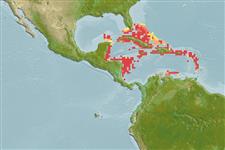Common names from other countries
Environment: milieu / climate zone / depth range / distribution range
Écologie
marin démersal; profondeur 1 - 27 m (Ref. 26268). Tropical; 27°N - 10°N, 89°W - 60°W (Ref. 26268)
Western Central Atlantic: Widespread through insular regions of the Caribbean Sea, including Glover's Reef, St. Eustatius, St. Barthelemy, and the French West Indies. Rarely captured along the continental margins of the Caribbean.
Length at first maturity / Taille / Poids / Âge
Maturity: Lm ?, range 3 - ? cm
Max length : 4.3 cm SL mâle / non sexé; (Ref. 53028); 5.7 cm SL (female)
Rayons mous dorsaux (Total) : 76 - 77; Rayons mous anaux: 61 - 62. Slender, small; pale with distinct, dark ocellated spots near rear of dorsal and anal fins.
Inhabits sandy substrates, also those submerged beds of aquatic vegetation, in clear shallow waters near coral reefs. Little is known of its biology since its captured infrequently and generally in small numbers; most captures were a single fish (Ref. 26268).
Life cycle and mating behavior
Maturities | Reproduction | Spawnings | Egg(s) | Fecundities | Larves
Böhlke, J.E. and C.C.G. Chaplin, 1993. Fishes of the Bahamas and adjacent tropical waters. 2nd edition. University of Texas Press, Austin. (Ref. 5521)
Statut dans la liste rouge de l'IUCN (Ref. 130435)
CITES (Ref. 128078)
Not Evaluated
Menace pour l'homme
Harmless
Utilisations par l'homme
Pêcheries: sans intérêt
Outils
Articles particuliers
Télécharger en XML
Sources Internet
Estimates based on models
Preferred temperature (Ref.
115969): 26.6 - 28.2, mean 27.4 (based on 290 cells).
Phylogenetic diversity index (Ref.
82804): PD
50 = 0.5000 [Uniqueness, from 0.5 = low to 2.0 = high].
Bayesian length-weight: a=0.01445 (0.00647 - 0.03228), b=3.05 (2.85 - 3.25), in cm Total Length, based on LWR estimates for this (Sub)family-body shape (Ref.
93245).
Niveau trophique (Ref.
69278): 3.2 ±0.4 se; based on size and trophs of closest relatives
Résilience (Ref.
120179): Haut, temps minimum de doublement de population inférieur à 15 mois (Preliminary K or Fecundity.).
Fishing Vulnerability (Ref.
59153): Low vulnerability (10 of 100).
